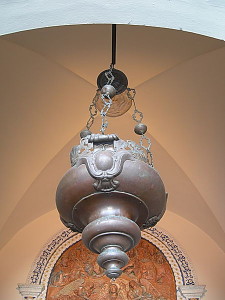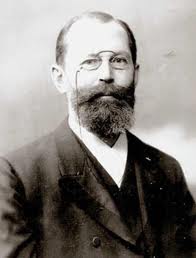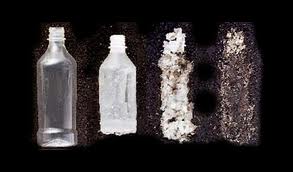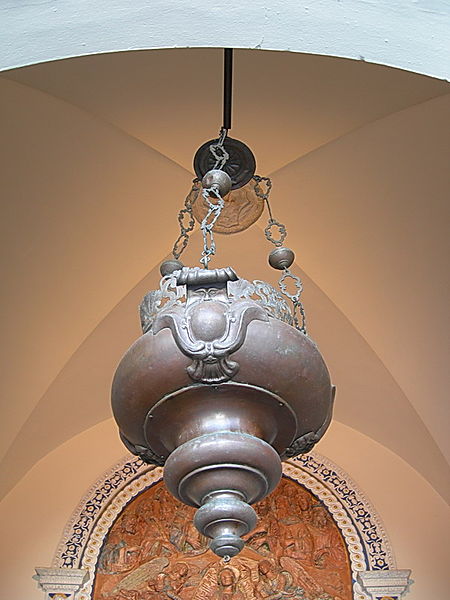 According to the tradition, Galileo Galilei discovered the law of the pendulum oscillations by observing those of the incense lamp that in his time was suspended in the center of the aisle of the cathedral of Pisa, and that we see in the image here on the side. To measure the period of oscillations of this pendulum, Galileo used the most accurate clock available at his time: its own heartbeat.
According to the tradition, Galileo Galilei discovered the law of the pendulum oscillations by observing those of the incense lamp that in his time was suspended in the center of the aisle of the cathedral of Pisa, and that we see in the image here on the side. To measure the period of oscillations of this pendulum, Galileo used the most accurate clock available at his time: its own heartbeat.
Certainly, the heartbeat can be a good reference to assess periodic regularity such as pendulum oscillations, but today we know that the heart rate clock is far from accurate. In fact, it is even more inaccurate the more one is in good health.
Let’s see how.
Continue reading
InSight
Science and Technology in Everyday Life
TIME WARP
 According to the tradition, Galileo Galilei discovered the law of the pendulum oscillations by observing those of the incense lamp that in his time was suspended in the center of the aisle of the cathedral of Pisa, and that we see in the image here on the side. To measure the period of oscillations of this pendulum, Galileo used the most accurate clock available at his time: its own heartbeat.
According to the tradition, Galileo Galilei discovered the law of the pendulum oscillations by observing those of the incense lamp that in his time was suspended in the center of the aisle of the cathedral of Pisa, and that we see in the image here on the side. To measure the period of oscillations of this pendulum, Galileo used the most accurate clock available at his time: its own heartbeat.
Certainly, the heartbeat can be a good reference to assess periodic regularity such as pendulum oscillations, but today we know that the heart rate clock is far from accurate. In fact, it is even more inaccurate the more one is in good health.
Let’s see how.
Continue reading

This is the first article in which, instead of limiting myself to exposing the established facts and theories of modern science, I indulge in adding a minimum of personal vision.
Not so much in the concepts outlined, but in looking for a link between them. To take a step back to look at the forest instead of focusing on the trees.
For this reason I need to mix together some arguments in the hope of highlighting the aspects that they have in common and to which we give different interpretations.
The two complementary aspects that are the heart of this article are separation and vagueness.
Continue reading
 In spite of the title, this article is NOT about politics!
In spite of the title, this article is NOT about politics!
Given that we are approaching the electoral period and given the fact that the electoral law in Italy is often the subject of discussion, I thought it might be interesting to know some mathematical curiosity about the methods of sharing and representing the will of the people.
Continue reading
 In this article, we still talk about chemistry and the substance that is the subject of our story is called glucose. But instead of exploring the properties and uses of glucose, we focus on what is a beautiful page of applied scientific method, dated to the late nineteenth century and starring the Nobel Prize for chemistry in 1902, the German chemist Emil Fischer, of which we see in a photograph reproduced here beside.
In this article, we still talk about chemistry and the substance that is the subject of our story is called glucose. But instead of exploring the properties and uses of glucose, we focus on what is a beautiful page of applied scientific method, dated to the late nineteenth century and starring the Nobel Prize for chemistry in 1902, the German chemist Emil Fischer, of which we see in a photograph reproduced here beside.
Continue reading
 This article is the natural continuation of “A plastic of world…“published some time ago. At that time we did a roundup of the most important “traditional” plastics commonly used in for containers and packaging.
This article is the natural continuation of “A plastic of world…“published some time ago. At that time we did a roundup of the most important “traditional” plastics commonly used in for containers and packaging.
In this article we will look at the frontier of technology that deals with plastics.
Continue reading
 Eyes unique in the world had a big contribution to the success of a great actress who was Liz Taylor.
Eyes unique in the world had a big contribution to the success of a great actress who was Liz Taylor.
The purple color of her eyes is due to a delicate balance of many factors, genetic and physiological, we will try to shed light on, in the article that follows.
 “Would you exchange your detergent XYZ with two buckets of a detergent whatever it is?”.
“Would you exchange your detergent XYZ with two buckets of a detergent whatever it is?”.
This catchphrase has been with us for many years as an evidence of a race to the improvement of a product that increasingly has become the icon of the modern world, clean and increasingly distant from the natural environment.
The picture on the right gives us an idea of the proliferation of substances designed to remove dirt in the most varied situations. But what differs and what is common to all these products? And how did that come about?
Continue reading
 Plastic is the generic name shared by a particularly large amount of materials that today have a wide and capillary diffusion and of which we have a daily experience, sometimes without even realizing it.
Plastic is the generic name shared by a particularly large amount of materials that today have a wide and capillary diffusion and of which we have a daily experience, sometimes without even realizing it.
Plastics, just because they are distinguished in many groups and subgroups, are extremely versatile. This means that they can be used in many different situations.
If we think, for example, of the plastic used in our cars, probably the first application that comes to mind is the instrument panel and the dashboard. On a second thought, even the seats are covered with a plastic material, suitably transformed to become a fabric. Not to mention the padding, which is a plastic foam to become soft.
It’s more difficult to associate the plastic to the bodywork, that instinctively we catalog as metal, but that too, in hindsight, is plastic coated, being the paint yet another variation of this ubiquitous substance.
Continue reading
![[cml_media_alt id='219']Dieci piccioni in nove caselle[/cml_media_alt]](https://insight.stefanopaladini.net/wp-content/uploads/2012/10/TooManyPigeons-300x243.jpg) The curious title of this page is the name of an important mathematical principle that is the argument of the following article.
The curious title of this page is the name of an important mathematical principle that is the argument of the following article.
 In this article I explore a topic of which everyone, more or less, have a summary knowledge that comes from the school: the inner ear and in particular the cochlea. Continue reading
In this article I explore a topic of which everyone, more or less, have a summary knowledge that comes from the school: the inner ear and in particular the cochlea. Continue reading
© 2024 InSight
Based upon a Anders Noren theme — Up ↑

 -0
-0  )
)